399 mudras pdf
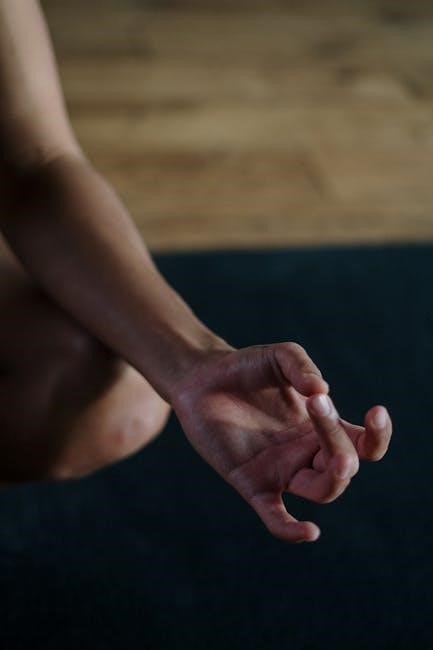
Mudras are ancient hand gestures practiced in yoga and meditation to channel and balance energy, promoting physical, mental, and spiritual well-being. This guide explores 399 mudras for holistic health.
What Are Mudras?
Mudras are specific hand gestures or postures that channel and balance the flow of energy in the body. Originating from ancient yoga and meditation practices, these gestures involve precise finger and hand positions. Each mudra is designed to influence the body’s energy, or prana, by stimulating specific pressure points. They are believed to enhance physical health, emotional well-being, and spiritual awareness. Mudras are not just physical gestures but also carry symbolic and metaphysical meanings. They are often used alongside breathing techniques and meditation to deepen the practice and promote harmony within the body and mind. Regular practice is said to unlock their full potential.
The Significance of Mudras in Yoga and Meditation
Mudras are powerful gestures that act as bridges between the physical and metaphysical, enhancing the flow of energy in the body. In yoga and meditation, they are used to channel and balance prana (life force), fostering harmony and well-being. By sealing or redirecting energy, mudras help practitioners access higher states of consciousness and emotional balance. They are integral to holistic health, offering benefits such as stress reduction, improved focus, and spiritual growth. Regular practice of mudras can deepen meditation, enhance yoga postures, and promote overall vitality, making them a cornerstone of ancient and modern wellness practices.
A Brief History of Mudras
Mudras trace their origins to ancient India, deeply rooted in Hinduism, Buddhism, and Jainism. These sacred gestures were first mentioned in the Vedas and Upanishads, dating back over 5,000 years. Initially used in rituals and spiritual practices, mudras were believed to connect the physical body with the divine. Over centuries, they evolved into precise techniques for balancing energy and enhancing meditation. Buddhist and yogic traditions further refined their use, incorporating them into formal practices. Today, mudras are recognized globally for their therapeutic and spiritual benefits, preserved and shared through ancient texts and modern guides like the 399 Mudras PDF.
The Science Behind Mudras
Mudras work by pressing specific points that stimulate nerves, affecting the brain and endocrine system. This influences energy flow, balancing the body and mind for optimal health and consciousness.
How Mudras Affect the Body and Mind
Mudras influence the body and mind by stimulating specific nerve endings in the hands, which connect to the brain and endocrine system. This interaction regulates energy flow, balancing emotions, and enhancing mental clarity. Regular practice improves physical health by boosting circulation and immune function, while mentally, it reduces stress and anxiety. Mudras also deepen meditation, fostering spiritual harmony and self-awareness. They act as tools for holistic healing, linking the physical and subtle bodies to promote overall well-being. Through consistent practice, mudras can transform one’s vitality, mindset, and connection to their inner self, offering a pathway to profound health and consciousness.
The Role of Mudras in Energy Flow (Prana)
Mudras serve as powerful tools to regulate and harmonize the flow of prana, the vital life force, within the body. By creating specific hand gestures, mudras act as energy seals that direct and balance the flow of prana. This practice enhances vitality, mental clarity, and spiritual awareness. Mudras work by stimulating nadis (energy channels) and chakras (energy centers), ensuring the free flow of prana. Regular practice helps in channeling energy to specific parts of the body, promoting physical and mental well-being. Mudras are essential for maintaining equilibrium in the body’s energy system, fostering a balanced and centered state of being.
Connection Between Mudras and Chakras
Mudras are deeply connected to the chakras, the energy centers in the body. Each mudra influences specific chakras, enhancing their function and promoting energy balance. By sealing specific hand gestures, mudras direct prana to flow through the nadis and chakras, harmonizing their energies. This connection allows mudras to address blockages, ensuring the free flow of energy. Regular practice strengthens the link between mudras and chakras, fostering physical, mental, and spiritual well-being. Understanding this relationship deepens the practice, making mudras a powerful tool for aligning and balancing the body’s energy system. This holistic approach enhances consciousness and overall vitality.
Types of Mudras
Mudras are categorized into Hasta (hand), Asana (postural), and Bandha (lock) types. These practices help channel energy, balance the body’s systems, and promote holistic well-being.
Common Hand Mudras (Hasta Mudras)
Hasta Mudras, or hand gestures, are potent practices that regulate energy flow in the body. They involve specific finger positions that influence the body’s vital forces. Common examples include Gyan Mudra (knowledge gesture), Prana Mudra (life force gesture), and Vayu Mudra (air gesture). These mudras are known to balance the five elements, enhance mental clarity, and promote physical health. Regular practice of Hasta Mudras can improve circulation, reduce stress, and boost immunity. They are simple, accessible, and can be performed anywhere, making them a popular choice for those seeking holistic well-being. Exploring these mudras can deepen your understanding of their transformative potential.
Postural Mudras (Asana Mudras)
Postural Mudras, or Asana Mudras, involve specific body postures that channel and balance life force energy (prana). These practices combine physical alignment with subtle energetic awareness. Examples include Padmasana (lotus pose) and Vajrasana (thunderbolt pose), which are known to enhance meditation and grounding. By aligning the body in these postures, one can experience improved concentration, reduced stress, and a deeper connection to inner energy. Asana Mudras are particularly effective for grounding and preparing the body for advanced practices like pranayama and meditation. Regular practice strengthens the body’s energetic structure and fosters a harmonious flow of prana, leading to holistic well-being and spiritual growth.
Lock Mudras (Bandha Mudras)
Lock Mudras, or Bandha Mudras, are powerful practices involving physical locks that control the flow of life force energy (prana) in the body. There are three main Bandhas: Mula Bandha (root lock), Uddiyana Bandha (abdominal lock), and Jalandhara Bandha (throat lock). These locks are activated through specific muscle contractions and are often used in conjunction with breath control (pranayama) to awaken and balance energy. Bandhas help in retaining and channeling prana, enhancing physical vitality and mental clarity. Regular practice strengthens the energy system, supports spiritual growth, and prepares the body for advanced meditative states. They are essential for harnessing and directing life force energy effectively.
Other Types of Mudras
Beyond the common categories, there are lesser-known mudras that offer unique benefits. Adi Mudra, for instance, involves curling the fingers into a fist, promoting grounding and stability. Khechari Mudra focuses on the tongue, believed to awaken higher consciousness. Shanmukhi Mudra involves closing the eyes, ears, and nose, fostering introspection. These mudras work on subtle energy channels and chakras, enhancing meditation and emotional balance. They are often practiced for specific spiritual or therapeutic purposes, making them valuable additions to a holistic practice. Exploring these diverse mudras can deepen one’s understanding of energy manipulation and its effects on overall well-being, offering a broader spectrum of benefits.
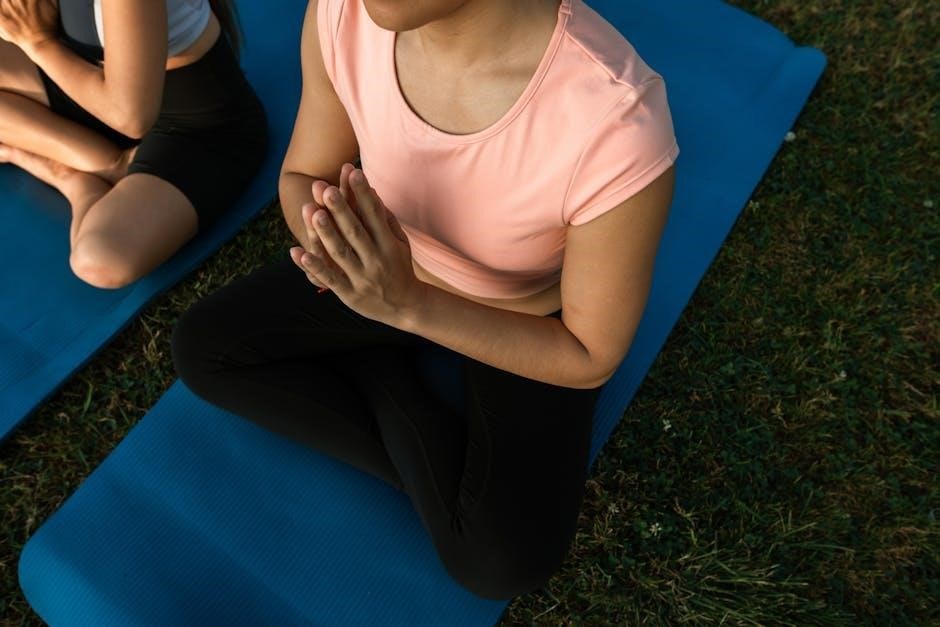
Top 399 Mudras for Holistic Well-being
Discover 399 powerful mudras tailored for physical, mental, and spiritual harmony, offering diverse techniques to enhance health, balance, and inner peace through ancient yogic practices.
Mudras for Physical Health
Mudras offer a natural way to enhance physical well-being by balancing bodily energies. Specific gestures like Gyan Mudra and Varun Mudra improve joint health and digestion. Regular practice strengthens immunity, reduces pain, and promotes vitality. Incorporating mudras into daily routines can alleviate chronic issues like hypertension and arthritis. For optimal benefits, practice mudras for 15–30 minutes, ideally in the morning. These simple, accessible techniques are perfect for maintaining overall physical health and preventing ailments. By targeting specific energy points, mudras provide a holistic approach to wellness, making them a valuable addition to any health regimen.
Mudras for Mental and Emotional Balance
Mudras are powerful tools for calming the mind and balancing emotions. Techniques like Apan Mudra and Prana Mudra help reduce stress and anxiety by harmonizing energy flow. Regular practice enhances focus, clarity, and emotional resilience. Specific gestures such as Shuni Mudra and Surya Mudra promote relaxation and positive thinking. Mudras also aid in managing depression, insomnia, and mood swings by stabilizing the nervous system. By channeling prana effectively, these practices foster mental peace and emotional stability. Incorporating mudras into daily routines can lead to long-term psychological well-being and a balanced emotional state, making them a simple yet profound self-care practice.
Mudras for Spiritual Growth

Mudras are potent practices for deepening spiritual growth by connecting the body, mind, and soul. Gestures like Gyan Mudra (seal of knowledge) and Chin Mudra enhance meditation and higher consciousness. Adi Mudra fosters inner peace, while Linga Mudra balances energies for spiritual awakening. These practices help quiet the mind, allowing for deeper self-reflection and connection to the divine. Regular mudra practice aids in awakening kundalini energy, promoting spiritual awareness and self-realization. By aligning the body’s energy, mudras create a conducive environment for meditation, enabling seekers to progress on their spiritual journey with clarity and purpose.
Lesser-Known but Powerful Mudras
While many mudras are widely recognized, some lesser-known gestures hold profound benefits. Kshobhana Mudra, for instance, transforms negative emotions into positive energy by stimulating the heart chakra. Varada Mudra cultivates compassion and blessings, promoting emotional healing. Pasha Mudra enhances vitality and strength, connecting to the root chakra. Matangi Mudra channels creative energy, balancing the sacral chakra and fostering emotional harmony. These rare mudras, though not as commonly practiced, offer unique advantages for specific energy imbalances. Exploring these hidden gems can deepen one’s practice, providing tailored solutions for holistic well-being and spiritual alignment. They remind us of the vast diversity within the ancient science of mudras.
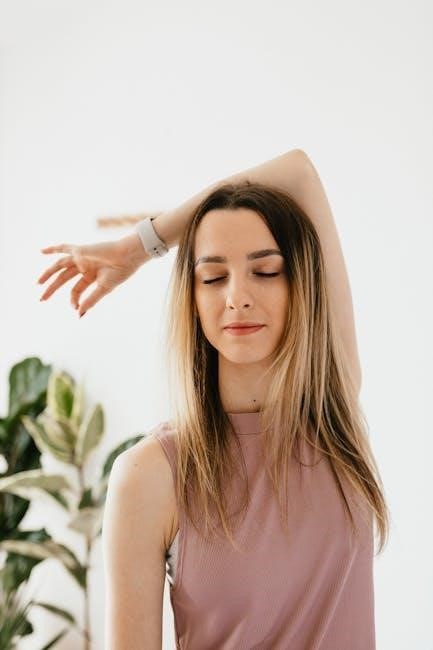
Benefits of Practicing Mudras
Practicing mudras balances energy, enhances physical health, calms the mind, and elevates spirituality, promoting holistic well-being and inner harmony through simple hand and body gestures.
Physical Benefits
Practicing mudras enhances physical health by improving circulation, boosting immunity, and reducing joint pain. They stimulate specific pressure points, balancing energy flow and strengthening organs. Certain mudras, like Gyan Mudra, improve nervous system function, while others, such as Varun Mudra, aid in detoxification and skin health. Regular practice can alleviate chronic conditions like arthritis and hypertension, promoting vitality and overall well-being. Mudras also improve flexibility and posture, making them a valuable complement to yoga and physical therapy. By targeting the body’s energy pathways, mudras offer a holistic approach to maintaining physical health and preventing disease.
Mental and Emotional Benefits
Mudras offer profound mental and emotional benefits by calming the mind and reducing stress. Regular practice enhances focus, concentration, and memory, fostering mental clarity. They help alleviate anxiety and depression by balancing emotional energy. Mudras like Gyan Mudra and Varada Mudra promote emotional stability, reducing mood swings. They also cultivate self-awareness and inner peace, aiding in emotional healing. By harmonizing energy flow, mudras empower individuals to manage stress and negativity, fostering resilience. This leads to improved emotional well-being, better decision-making, and a more positive outlook on life. Incorporating mudras into daily routine can transform mental and emotional health, creating a balanced and harmonious state of being.
Spiritual Benefits
Mudras hold profound spiritual significance, serving as a bridge between the physical and divine. They facilitate a deeper connection to the universe, fostering spiritual awakening and self-realization. Regular practice enhances intuition, purifies the mind, and elevates consciousness. Mudras like Adi Mudra and Linga Mudra help activate higher chakras, particularly the Sahasrara, promoting enlightenment. They quiet the mind, enabling meditative states and inner peace. By channeling divine energy, mudras aid in spiritual growth, helping practitioners transcend worldly attachments. They create a sense of oneness with the universe, aligning individuals with their true purpose. This spiritual alignment leads to profound inner transformation and eternal bliss.
How to Practice Mudras Correctly
Practice mudras by sitting comfortably, maintaining proper posture, and focusing on your breath. Perform each mudra with precision, ensuring fingers align correctly. Ideal for morning practice, mudras enhance energy flow when done consistently.
Step-by-Step Guide to Performing Mudras
To perform mudras correctly, start by sitting comfortably with a straight spine. Choose a mudra from the 399 mudras guide and align your fingers as described. Focus on your breath, ensuring relaxation. Hold the mudra for 5-15 minutes, depending on its purpose. Practice regularly, ideally in the morning, to enhance benefits. Use a guidebook or PDF to ensure accuracy in finger placement and posture. Consistency is key for experiencing the full effects of each mudra.
Duration and Frequency of Practice
For optimal benefits, practice mudras consistently, ideally once or twice daily. Begin with 5-10 minutes per session and gradually increase to 15-30 minutes as comfort allows. Healing-focused mudras may require longer durations, while spiritual practices benefit from shorter, regular sessions. Frequency varies by purpose: stress-relief mudras can be done daily, while advanced practices may require less frequent but dedicated sessions. Adapt timing based on individual goals and energy levels. Consistency is more important than duration for harnessing the full potential of these practices.
Contraindications and Precautions
While mudras are generally safe, certain precautions must be observed. Individuals with severe hand or wrist injuries should avoid complex hasta mudras. Pregnant women should consult experts before practicing bandha mudras, as they may affect internal pressure. Those with chronic illnesses or recent surgeries should modify practices under professional guidance. Avoid overexertion or forceful posturing, as it may cause discomfort. Practice gently and within your comfort zone. If experiencing pain or dizziness, discontinue the mudra immediately. Always combine mudras with proper breathing techniques to enhance safety and effectiveness. Prioritize mindfulness and listen to your body to avoid adverse effects.

Advanced Mudra Practices
Advanced mudra practices involve complex postures, prolonged durations, and synchronization with breathwork. They require precision and dedication, amplifying physical, mental, and spiritual benefits significantly.
Combining Mudras with Pranayama
Combining mudras with pranayama enhances their effects, creating a powerful synergy for holistic well-being. This advanced practice balances energy, calms the mind, and harmonizes the body. Specific pranayama techniques, like Anuloma Viloma (alternate nostril breathing), paired with Gyan Mudra, stimulate the third eye, improving focus and intuition. Similarly, Bhramari Pranayama with Chin Mudra soothes the nervous system. Regular practice deepens meditation, enhances respiratory health, and awakens spiritual consciousness. This integrated approach is ideal for experienced practitioners seeking to amplify their mudra practice. It is a profound way to connect breath, gesture, and awareness for transformative results.
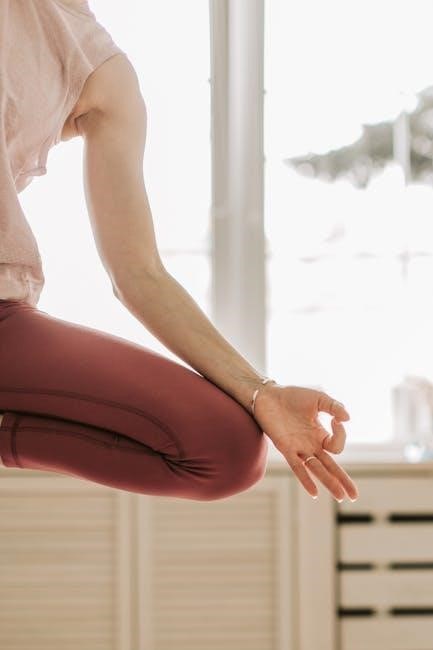
Using Mudras in Meditation
Using mudras in meditation enhances focus, calmness, and spiritual connection. These gestures act as tools to channel and balance energy, helping to quiet the mind. Gyan Mudra, for instance, stimulates knowledge and wisdom, while Chin Mudra promotes relaxation. Practicing mudras during meditation deepens the experience, fostering inner peace and self-awareness. They help align the body’s energy with the mind’s intent, creating a harmonious state. Regular use of mudras in meditation can lead to heightened consciousness, emotional balance, and a stronger connection to one’s spiritual essence. This practice is a powerful way to enhance meditation and achieve profound inner transformation.
Sequencing Mudras for Maximum Effect
Sequencing mudras intentionally enhances their impact by aligning with the body’s energy flow. A well-planned sequence can amplify physical, mental, and spiritual benefits. For example, starting with grounding mudras like Apan Mudra, then transitioning to energizing gestures such as Prana Mudra, and finishing with meditative mudras like Gyan Mudra creates a balanced practice. This progression awakens, balances, and channels energy effectively. Proper sequencing ensures that each mudra builds upon the previous one, optimizing the overall experience. By tailoring sequences to specific goals—whether for health, meditation, or spiritual growth—practitioners can achieve profound and targeted results. This mindful approach maximizes the transformative potential of mudras.

Resources for Learning Mudras
Explore the 399 Mudras PDF for detailed insights into various gestures. Access online guides, e-books, and websites offering comprehensive mudra techniques and practices for holistic well-being.
Recommended Books on Mudras
Discover the 399 Mudras PDF and explore books like Mudra: The Sacred Secret by Swami Satyananda Saraswati, offering insights into hand gestures for health and spirituality. The Mudra Handbook by Keshav Dev provides practical techniques, while Mudras for Modern Life by Swami Saradananda blends tradition with contemporary practices. These texts are essential for understanding mudras’ role in yoga, meditation, and energy flow. They detail physical, mental, and spiritual benefits, making them invaluable for practitioners seeking holistic well-being. These resources complement the 399 Mudras PDF, offering a deeper dive into mudra science and applications.
Online Courses and Tutorials
Explore online courses and tutorials to deepen your understanding of the 399 Mudras PDF. Platforms like Udemy and Coursera offer courses such as Mudras for Holistic Health and Advanced Mudra Techniques. These courses provide step-by-step guides, video demonstrations, and practical tips for incorporating mudras into daily life. Websites like Yoga International and DoYouYoga also feature tutorials that align with the principles outlined in the 399 Mudras PDF. These resources are ideal for beginners and advanced practitioners alike, offering structured learning paths to master mudras for physical, mental, and spiritual well-being. They complement the PDF guide, ensuring a comprehensive learning experience.
PDF Guides and E-books
Discover comprehensive 399 Mudras PDF guides and e-books that detail various mudras for holistic well-being. These resources are available on platforms like Etsy, Amazon, and specialized yoga websites. E-books such as The Complete Guide to Mudras and Mudras for Modern Life offer detailed instructions, diagrams, and benefits of each mudra. Many PDF guides include high-resolution images and step-by-step instructions, making them accessible for both beginners and advanced practitioners. These digital resources are perfect for those seeking a structured approach to learning and practicing mudras. They are often downloadable, allowing for easy reference during practice or study.
Key Takeaways from the 399 Mudras Guide
The 399 Mudras PDF provides a detailed exploration of 399 unique mudras, offering insights into their benefits and applications for holistic well-being. It emphasizes the integration of physical postures, hand gestures, and breathwork to balance energy and consciousness. The guide highlights mudras for specific purposes, such as improving health, calming the mind, and deepening spiritual connection. With clear instructions and visual aids, it serves as a practical resource for both beginners and advanced practitioners. By incorporating these mudras into daily routines, individuals can experience profound transformations in their overall well-being and spiritual growth, making it an essential tool for anyone seeking self-awareness and inner harmony.
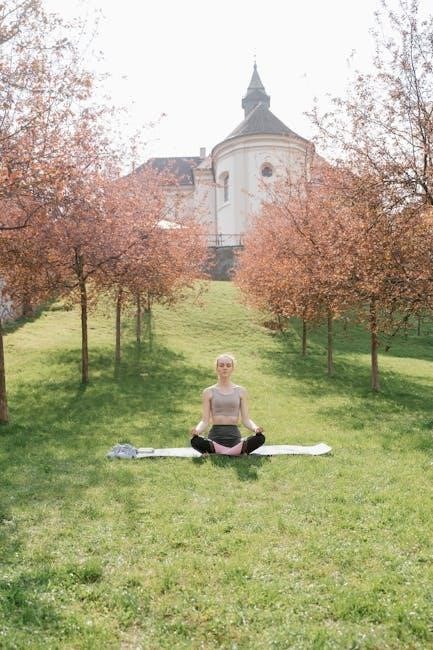
Encouragement for Further Exploration
Embark on a transformative journey with the 399 Mudras PDF, a comprehensive guide to unlocking the full potential of mudras. This resource encourages practitioners to explore beyond the basics, discovering how these ancient gestures can enhance physical, mental, and spiritual well-being. Experiment with different techniques, combine mudras with meditation or breathwork, and tailor practices to personal goals. The guide inspires curiosity and creativity, urging readers to embrace mudras as a lifelong tool for self-discovery and growth. With dedication and openness, the benefits of mudras can deepen, fostering a profound connection to the body, mind, and spirit.
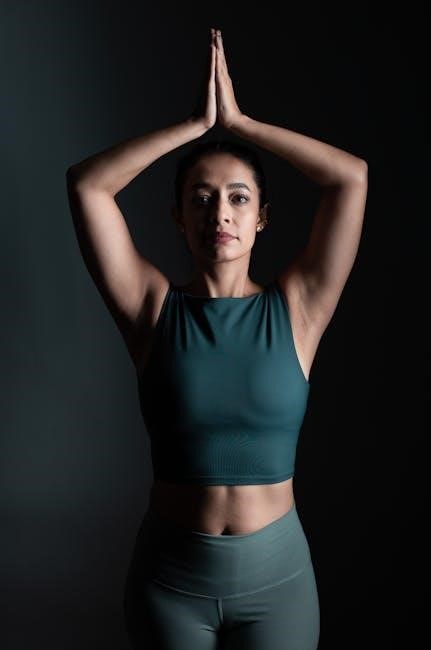
References
Consult the 399 Mudras PDF for detailed insights, supported by credible sources like ancient yogic texts, scholarly articles, and expert practitioners’ teachings.

Books and Academic Sources
For in-depth understanding, refer to books like “Mudras: Yoga in Your Hands” by Gertrud Hirschi and “The Yoga of the Hands” by Hirschi, offering detailed insights into mudras.
Academic journals such as the Journal of Ayurveda and Integrative Medicine explore mudras’ impact on health. The 399 Mudras PDF compiles practices from ancient texts and modern research.
Websites like Academia.edu and ResearchGate provide scholarly articles on mudras’ benefits and historical significance. These resources ensure a well-rounded understanding of mudras.
Online Resources and Websites
Explore reputable websites like YouTube for mudra tutorials and explanations by experts.
Websites such as MindBodyGreen and DoYouYoga offer detailed guides and articles on mudras.
E-learning platforms like Udemy and Coursera provide structured courses on yoga and mudras.
Additionally, websites like Google Drive and Scribd host free PDF resources, including the 399 Mudras PDF.
Online communities on Facebook and specialized forums share practitioner experiences and tips.
These resources make learning mudras accessible and engaging for everyone.
Expert Opinions and Testimonials
Yoga masters and holistic healers endorse the 399 Mudras PDF as a comprehensive guide.
Experts like Dr. Swami Satyananda Saraswati highlight its clarity in explaining intricate mudras.
Practitioners praise the guide for its detailed instructions and holistic benefits.
Renowned yoga therapist B.K.S. Iyengar commends its focus on mental and physical well-being.
Testimonials reveal transformative experiences, with users reporting improved health and emotional balance.
One practitioner shared, “The guide helped me overcome chronic stress and reconnect with my inner self.”
Such endorsements underscore the PDF’s value as a trusted resource for spiritual and physical growth.
Experts agree that consistent practice with this guide fosters profound self-awareness and harmony.